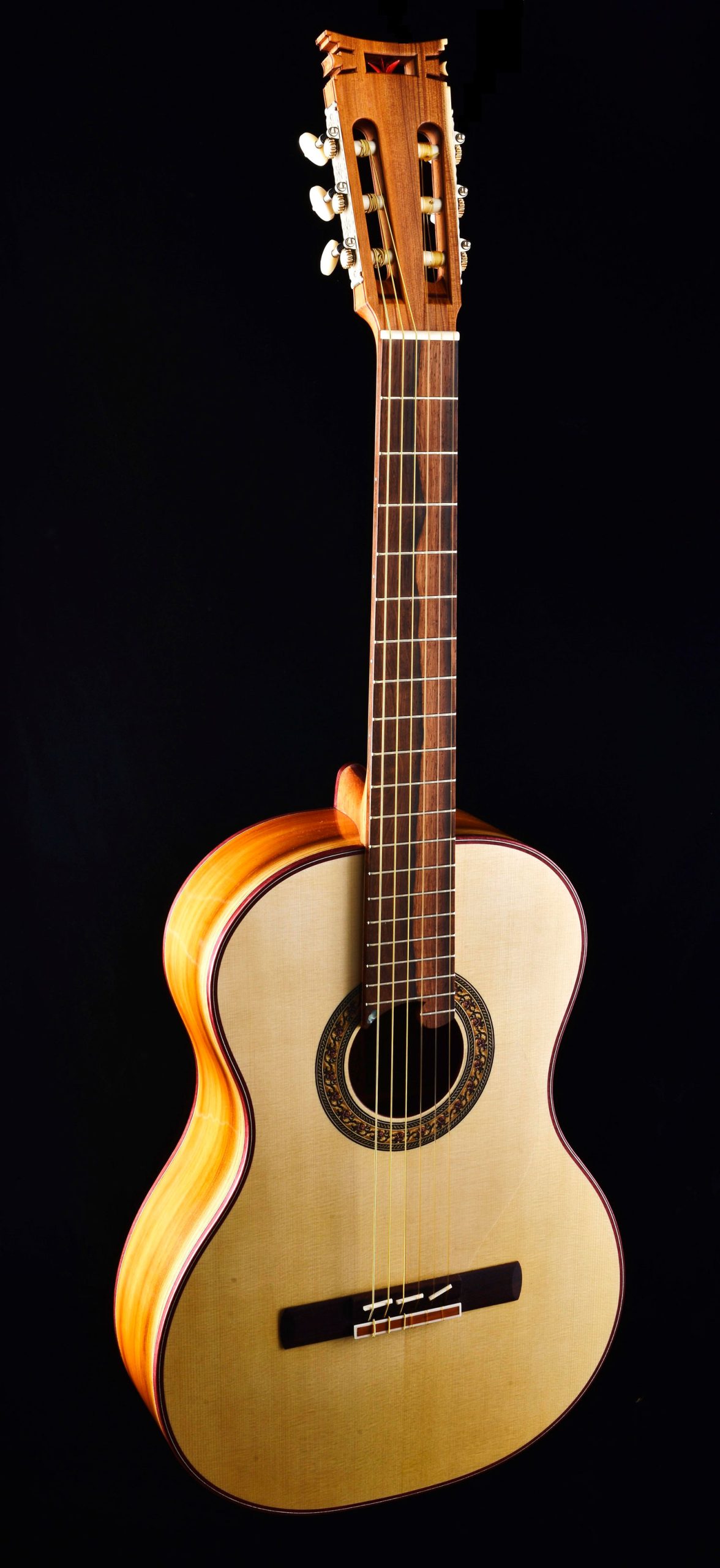
traditional spanish construction, according to own design
Model: Classico Torii
Type: Classical guitar
Origin: Germany
Body: solid Yew wood
Top: Alpine spruce
Binding: Amaranth underlaid with 3-piece decorative shavings
Bracing: Lattice
Neck: Cedro, locked with Amaranth and between veneers Walnut
Headstock: Yew backed on both sides with Amaranth Walnut veneer and elaborated collar
Sound hole Ring: Mosaic
Fingerboard: Madagascar Rosewood
Frets: 20
Mechanic: Rubner El Sonido
Bridge: East Indian rosewood, with adjustable lower saddle String
Nut/bridge rests: Bone
Scale: 650 mm, 4/4
Neck width: upper saddle 52mm, 12th fret 62 mm
Finish: shellac polish
Katharina Godolt (Kate Go) plays Theme and Variations on „Sakura“ by Yuquijiroh Yocoh.

traditional spanish construction, own design
Body: Back and sides massive plumwood
Top: Alpine spruce
Binding: Plum wood with 3 ply purfling
Bracing: Fan bracing
Neck: Cedro, rosewood
Head plate: Plumwood two sided
Sound hole rosette: Massive plumwood
Fingerboard: Zirikote
Frets: 20
Mechanics: Rubner mounted shaft with ball-bearing
Bridge: Zirikote
Saddle: Bone
Scale: 650 mm
Dimension neck: Saddle: 52mm, 12. fret: 62mm
Finish: French polish

traditional spanish construction, own design
Body: Back and sides massive olivewood, back duplicated with spruce
Top: Alpine spruce
Binding: Plum wood with 3 ply purfling
Bracing: Fan bracing inspired by Daniel Friedrich
Neck: Alder, plum wood
Head plate: Olivewood two sided
Sound hole rosette: Massive olivewood
Fingerboard: Indian rosewood from the 60´s
Frets: 20
Mechanics: Gotho
Bridge: Indian rosewood from 60´s with FABS, free adjustable bridge saddle
Saddle: Bone
Scale: 650 mm
Dimension neck: Saddle: 52mm, 12. fret: 62mm
Finish: French polish
Click on the image for a larger view.
Special Features, Options & Customer Service
Bridge
The FABS (i.e. free adjustable bridge saddle) is characterized by a slightly angled plane on which the bone saddle rests, held in place by the pressure applied by the strings. When exchanging the strings, it is important to replace one stringat a time so as not to change the position of the bone saddle. If the position is changed, adjustment is required.
In the case that adjustment is required, the following steps should be taken:
1. Tune strings with tuning device.
2. Pluck the open harmonic (strings not depressed) and compare with the tone produced while plucking the string depressed at the 12th fret.
3. If the tone produced from plucking the depressed string is sharp compared to the open harmonic, the bridge saddle must be moved in the direction from the sound hole towards the tailblock.
4. If the tone produced from plucking the depressed string is flat compared to the open harmonic, the bridge saddle must be moved in the direction of the sound hole, away from the tailblock.
The steps are to be repeated for all strings, allowing for the exact adjustment of the tone.
No “Cutaway”
My basses are characterized by a modified rib detail in place of the traditional “cutaway” in order to maximized on the volume of the body. This allows the musician to comfortably reach the 24th fret (second octave). The volume of the body allows for the development of lower frequencies.
The construction of basses is designed to produce low tones in particular. In order to achieve these tones, the specific width of the ribs has been increased, the size of the sound hole has been reduced in order to deepen the resonance of the instrument body (the deepest resonance of the air capacity), and the sound hole has been moved to the left upper bow or in the rib.
Pickup
Each bass features an installed passive pickup (transducer). On stage or in the practice room, it is helpful to be able to amplify the sound. The pickup is located directly under the bridge and is physically connected with the soundboard of the instrument.
The vibration of the soundboard can be recorded and adjusted directly via a mixer or using an amplifier. The system is completely passive and does not require batteries. An internal microphone from HIGHLANDER can be installed as an optional feature for a fee.
An external equalizer from K&K Sound can also be installed as a supplement.
All microphones and pickups that are offered feature minimal feedback. Sound hole covers made out of dense foam rubber and a wood can be crafted as required. The covering can be installed at any time to substantially reduce the feedback, particularly for live performances.
Varnishing and Surface Treatment
Natural resins and oils are used to provide the finish for the instrument surface. In contrast to layers of artificial varnish, the use of natural products has many advantages. Shellac is applied to the surface of the instrument by hand in many thin layers and then polished. I do not use any harmful or potentially hazardous thinners. The shellac is dissolved in ethyl alcohol and applied using paint brushes and polishing cloths. The surface pores are sealed and a high-gloss finish is achieved.
The back side of the neck is treated with a linseed oil primer and a layer of natural wax, providing a matt finish, and a more natural handling. The shellac finish on my instruments can be touched up, free of cost and included in customer service.
String Spacing and Additional Dimensions of the Neck, etc.
The width and thickness of the neck can be made according to customer specifications.
Special requests or personalizations can be taken into consideration. 5-string basses are available in two different tunings: lower B string = H2- E1-A1-D-G, or high C string = E1-A1-D-G-c.
Each bass can be constructing with or without frets (fretless), or for left-handers at no additional cost.
The standard string spacing on the bridge is 19 mm for 4-string basses and 17 mm for 5 and 6-string basses. The string spacing can be adjusted according to customer specifications.
Services
My expert services include instrument adjustment, e.g. neck correction, string height adjustment, fret levelling, replacement of frets, minimal repair work and gluing of cracks. Adjustment, polishing and fret levelling are provided free of cost for instruments created in my workshop.


